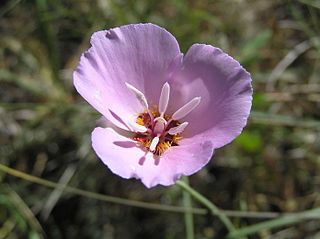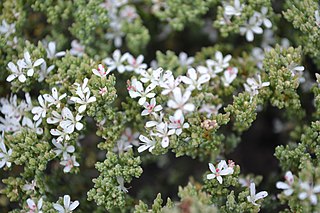
Tigridia, is a genus of bulbous or cormous flowering plants belonging to the family Iridaceae. With common names including peacock flowers, tiger-flowers or shell flowers, they have large showy flowers; and one species, Tigridia pavonia, is often cultivated for this. The approximately 60 species in this family grow in the Americas, from Mexico down to Chile.

The Polemoniaceae are a family of flowering plants consisting of about 27 genera with 270–400 species of annuals and perennials native to the Northern Hemisphere and South America, with the center of diversity in western North America.

Lomatium is a genus in the family Apiaceae. It consists of about 100 species. Its common names include biscuitroot, Indian parsley, and desert parsley. It is in the family Apiaceae and therefore related to many familiar edible species such as carrots and celery. Native to western Northern America and northern Mexico, some Lomatium species are extensively used by Native Americans in the inland Pacific Northwest as a staple food.

Iresine is a genus of flowering plants in the family Amaranthaceae. It contains 20 to 25 species, all of which are native to the American tropics. The generic name is derived from the Greek word ερι�i>erios), meaning "wooly", referring to the trichome-covered flowers. Bloodleaf is a common name for those species that have colored foliage, and these are often cultivated as ornamental plants. Some species are additives to versions of the hallucinogenic drink ayahuasca.

Gilia is a genus of flowering plants in the Polemoniaceae family and is related to phlox. It includes 39 species native to the Americas, ranging from British Columbia to Texas and northern Mexico, and to Ohio, in North America, and from Ecuador and Peru to southern Chile and Argentina in South America. These Western native plants are best sown in sunny, well-draining soil in the temperate and tropical regions of the Americas, where they occur mainly in desert or semi-desert habitats

Castilleja exserta is a species of plant in the genus Castilleja which includes the Indian paintbrushes. Its common names include purple owl's clover, escobita, and exserted Indian paintbrush.

Heliocarpus is a genus of flowering plants in the family Malvaceae. It was formerly classified in the Tiliaceae.

Calochortus palmeri is a species of flowering plant in the lily family known by the common names Palmer's mariposa lily and strangling mariposa.

Aliciella is a genus of plants in the phlox family. It includes 23 species native to the western United States and northwestern Mexico. These plants have been treated as members of genus Gilia until recently, when it was proposed they be moved back to Aliciella. This genus was created in 1905 to include certain gilias that seemed distinct from most of the others, but it was abandoned soon after. Recent genetic analyses suggest it should be revived.

Frankenia is the only genus in the Frankeniaceae family of flowering plants. Other genera have been recognized within the family, such as Anthobryum, Hypericopsis and Niederleinia, but molecular phylogenetic studies have consistently shown that they all belong inside Frankenia. Frankenia comprises about 70–80 species of shrubs, subshrubs and herbaceous plants, adapted to saline and dry environments throughout temperate and subtropical regions. A few species are in cultivation as ornamental plants.

Hebecarpa is a genus of flowering plants belonging to the family Polygalaceae. Species are found from the southern United States through Mexico and Central America to western South America.

Loeselia is a genus of flowering plants in the phlox family Polemoniaceae, native to the southwestern United States, Mexico, Central America, Columbia and Venezuela. A number of species are found only in the Balsas Depression of southwestern Mexico.
Tetrapteron is a genus of flowering plants belonging to the family Onagraceae.
Dayia is a genus of flowering plants belonging to the family Polemoniaceae.
Rhodosciadium is a genus of flowering plants belonging to the family Apiaceae.
Dryopetalon is a genus of flowering plants belonging to the family Brassicaceae.

Elmera racemosa is a species of flowering plant belonging to the family Saxifragaceae. It is the sole species in genus Elmera.
Giliastrum is a genus of flowering plants belonging to the family Polemoniaceae.

Gaudichaudia is a genus of flowering plants belonging to the family Malpighiaceae.













